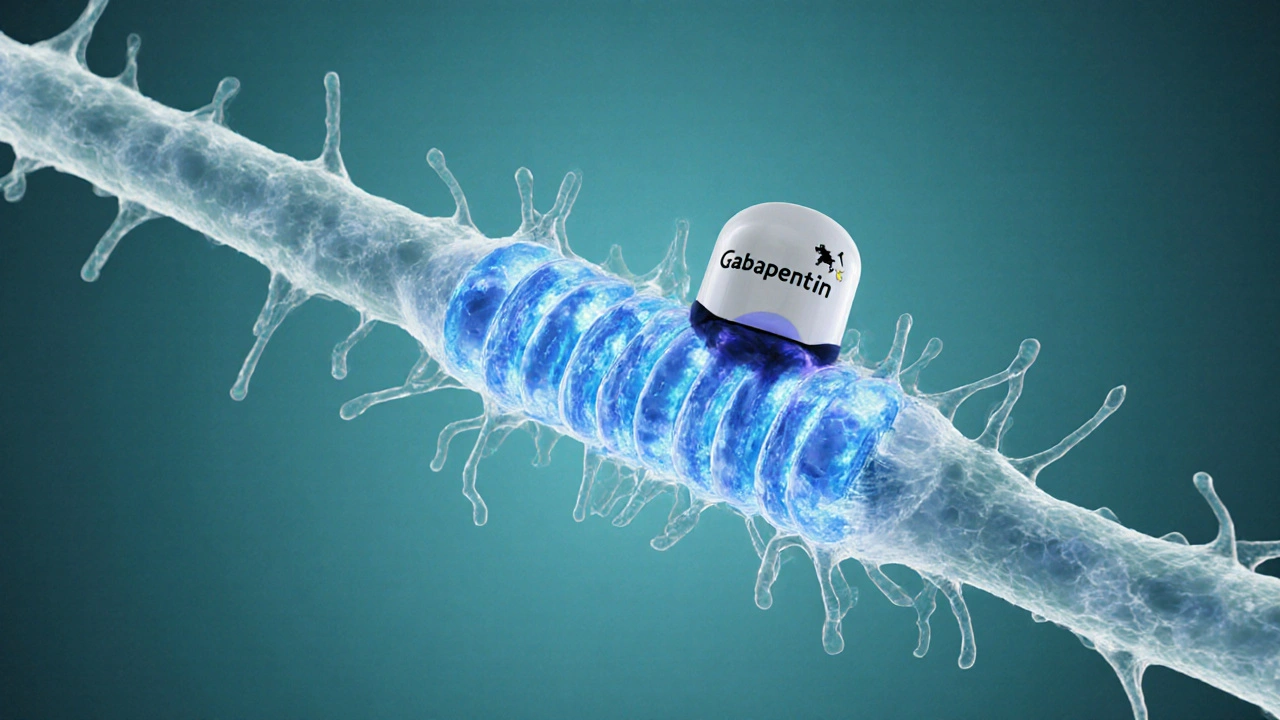Gabapentin vs Alternatives Comparison Tool
Use this tool to compare Gabapentin and its main alternatives based on efficacy, side effects, and cost.
Recommended Alternatives Based on Your Profile
Best for: Cost-sensitive patients, mild to moderate neuropathy
Side Effects: Dizziness 30-40% Weight Gain 5-10% Edema 2-5%
Cost: $5-$15/month (Generic)
Dosing: Once daily, titratable up to 1800mg/day
Best for: Rapid onset, high potency
Side Effects: Dizziness 20-30% Weight Gain 12-15% Edema 5-8%
Cost: $120-$250/month (Brand)
Dosing: Once daily, titratable up to 600mg/day
Best for: Patients with comorbid depression/anxiety
Side Effects: Dizziness 10-20% Weight Gain 8-12% Edema 2-4%
Cost: $60-$120/month (Brand)
Dosing: Starting dose 30-60mg daily
Best for: Focal nerve pain, trigeminal neuralgia
Side Effects: Dizziness 15-25% Weight Gain 3-5% Edema 1-3%
Cost: $20-$30/month (Generic)
Dosing: 200mg twice daily, up to 1200mg/day
Best for: Older adults with sleep issues
Side Effects: Dizziness 25-35% Weight Gain 5-10% Edema 3-6%
Cost: $10-$20/month (Generic)
Dosing: Low-dose at bedtime (10-25mg)
Recommendation Engine
Based on your selected condition and budget, Gabapentin is typically the most cost-effective option. However, if rapid onset or mood support is critical, Pregabalin or Duloxetine might be better suited.
If you’ve been prescribed Gabapentin alternatives and are wondering whether Neurontin is still the best fit, you’re not alone. In the past few years new drugs, updated dosing guidelines, and shifting insurance formularies have turned the decision into a nuanced trade‑off. This guide walks you through how Gabapentin works, what the most common substitutes are, and which factors matter most when you compare them.
How Gabapentin (Neurontin) Works
When treating neuropathic pain, Gabapentin is a synthetic analog of the neurotransmitter GABA that binds to the α2δ subunit of voltage‑gated calcium channels, dampening abnormal neuronal firing. It was first approved by the FDA in 1993 for seizures and later labelled for post‑herpetic neuralgia. Because it doesn’t act directly on GABA receptors, the drug often avoids the classic sedative profile of true GABA agonists, yet drowsiness and dizziness remain common side effects.
When Doctors Choose Gabapentin
Typical indications include:
- Peripheral neuropathy (diabetic, chemotherapy‑induced)
- Post‑herpetic neuralgia
- Fibromyalgia (off‑label)
- Partial seizures as an adjunct therapy
Dosage usually starts low-300mg once daily-and titrates up to 900‑1800mg split into three doses, depending on renal function and tolerability. The drug is inexpensive, widely covered by public formularies, and available in generic form.
Key Criteria for Comparing Alternatives
Before you jump to a different pill, line up the following factors:
- Efficacy for your condition - clinical trial data and real‑world response rates.
- Side‑effect profile - dizziness, weight gain, edema, mood changes.
- Onset of relief - how quickly you feel pain reduction.
- Dosing convenience - once‑daily vs multiple times per day.
- Cost and insurance coverage - generic price vs branded premium.
- Drug interactions - especially with opioids, antidepressants, or antiepileptics.
Top Alternatives to Gabapentin
Below are the most frequently switched‑to medications, each introduced with microdata markup for easy indexing.
Pregabalin (brand name Lyrica) is a second‑generation calcium‑channel α2δ ligand that shares a similar mechanism with Gabapentin but is more potent and has a faster titration schedule. FDA‑approved for neuropathic pain, fibromyalgia, and as an adjunct for seizures. Typical dosing ranges from 150mg once daily up to 600mg divided twice daily. It often provides pain relief within one week, but the price is higher because it remains under patent in many markets.
Carbamazepine is a sodium‑channel blocker historically used for trigeminal neuralgia and certain seizure types. While not a first‑line neuropathic‑pain drug, it can be effective for focal nerve pain. Doses start at 200mg twice daily, with a therapeutic window of 800‑1200mg. Major downsides include risk of hyponatremia, liver enzyme elevation, and a need for blood‑level monitoring.
Duloxetine is a serotonin‑norepinephrine reuptake inhibitor (SNRI) that treats both depression and chronic musculoskeletal pain, including diabetic neuropathy. It works upstream of calcium‑channel modulation, offering a dual‑benefit for patients with mood disorders. Standard dosing is 30mg daily for one week, then 60mg; some clinicians increase to 120mg. Side effects can include nausea, dry mouth, and increased blood pressure.
Amitriptyline is a tricyclic antidepressant that blocks reuptake of serotonin and norepinephrine while also exhibiting antihistamine and anticholinergic activity. Low‑dose (10‑25mg at bedtime) is commonly used for neuropathic pain and insomnia. Its anticholinergic side effects-dry mouth, constipation, blurred vision-can limit use in older adults.
Non‑steroidal anti‑inflammatory drugs (NSAIDs) such as ibuprofen or naproxen are cyclo‑oxygenase inhibitors that mainly address inflammatory pain rather than neuropathic mechanisms. They are inexpensive and over‑the‑counter, but they provide limited relief for nerve‑based pain and carry risks of gastrointestinal bleeding and cardiovascular events.
Side‑Effect Snapshot
Understanding tolerability helps you decide whether to stay with Gabapentin or switch.
| Medication | Dizziness/Vertigo | Weight Gain | Edema | Mood Changes | Cost (USD per month) |
|---|---|---|---|---|---|
| Gabapentin | 30‑40% | 5‑10% | 2‑5% | 3‑7% | $5‑$15 (generic) |
| Pregabalin | 20‑30% | 12‑15% | 5‑8% | 5‑10% | $120‑$250 (brand) |
| Carbamazepine | 15‑25% | 3‑5% | 1‑3% | 2‑6% | $20‑$30 (generic) |
| Duloxetine | 10‑20% | 8‑12% | 2‑4% | 4‑9% | $60‑$120 (brand) |
| Amitriptyline | 25‑35% | 5‑10% | 3‑6% | 6‑12% | $10‑$20 (generic) |
| NSAIDs | 5‑10% | 2‑4% | 1‑2% | 1‑3% | $5‑$15 (over‑the‑counter) |
Best‑Fit Scenarios
Here’s a quick decision guide based on common patient profiles:
- Cost‑sensitive, mild to moderate neuropathy: Stay with Gabapentin. Generic price and once‑daily dosing (if tolerated) keep the budget low.
- Rapid pain relief needed, willing to pay a premium: Switch to Pregabalin. Faster titration and higher potency often shave weeks off the waiting period.
- Co‑existing depression or anxiety: Duloxetine tackles both mood and nerve pain, cutting the pill burden.
- Focal, shooting pain (e.g., trigeminal neuralgia): Carbamazepine remains the gold standard despite blood‑level monitoring.
- Older adult prone to anticholinergic side effects: Avoid Amitriptyline. Consider low‑dose Gabapentin or Pregabalin instead.

How to Switch Safely
Never quit a medication cold. Follow these steps:
- Consult your prescriber to confirm the new drug’s indication for your specific pain condition.
- Establish a taper schedule for Gabapentin-typically reduce the total daily dose by 300mg every 3‑5 days, adjusting for renal function.
- Start the substitute at the lowest recommended dose. For Pregabalin, that would be 75mg once daily; for Duloxetine, 30mg daily.
- Monitor for breakthrough pain or new side effects. Keep a brief diary for the first two weeks.
- Schedule a follow‑up visit (in‑person or telehealth) after 2‑4 weeks to fine‑tune dosing.
If you experience severe withdrawal (e.g., anxiety, insomnia, seizures), contact your clinician immediately-though such reactions are rare with gradual taper.
Frequently Asked Questions
Frequently Asked Questions
Can I take Gabapentin and Pregabalin together?
Generally no. Both drugs act on the same calcium‑channel subunit, so combining them increases the risk of dizziness, edema, and respiratory depression without offering extra pain relief. Your doctor might consider a short overlap during a switch, but long‑term co‑administration is discouraged.
Is Gabapentin still effective after a year of use?
Effectiveness can wane for some patients due to tolerance. If pain returns, a dose adjustment, holiday break, or switch to a different class (e.g., an SNRI) may restore control.
What insurance coverage differences exist between Gabapentin and Pregabalin?
Most public plans list generic Gabapentin as a preferred drug with $0‑$10 co‑pay. Pregabalin, being brand‑only in many countries, often falls under a higher tier, leading to co‑pays of $30‑$80. Check your formulary for any required prior authorizations.
Are there any foods or drinks I should avoid while on Gabapentin?
Alcohol can amplify dizziness and sedation, so limit intake. High‑salt meals may worsen edema for some users, though evidence is limited. Staying hydrated helps kidney clearance, especially for those with reduced renal function.
What’s the biggest advantage of Duloxetine over Gabapentin?
Duloxetine treats both chronic nerve pain and depressive symptoms, making it a two‑bird‑one‑stone option for patients struggling with mood changes alongside pain.
Bottom Line
Choosing between Gabapentin and its alternatives isn’t a one‑size‑fits‑all decision. If you value low cost, a familiar safety profile, and are comfortable with a gradual titration, Gabapentin remains a solid first‑line choice. When rapid relief, dual‑action on mood, or a specific pain type (like trigeminal neuralgia) matters more, Pregabalin, Duloxetine, or Carbamazepine may edge ahead.
Talk with your healthcare provider about your pain severity, other health conditions, and insurance situation. A personalized plan-sometimes a simple switch, sometimes a combination-will give you the best odds of getting back to daily life without constant ache.



Gabapentin is cheap, but the dizziness and weight gain are a nightmare.
While the comparative chart purports to be an impartial guide, a closer inspection reveals a cascade of methodological oversights; the cost figures, for instance, ignore regional pricing differentials, thereby inflating the apparent affordability of generic gabapentin. Moreover, the side‑effect percentages are presented without confidence intervals, rendering the risk assessment ambiguous. The author also neglects to disclose the source of the efficacy data, which appears to be cherry‑picked from a subset of open‑label trials. Readers should be wary of the implied superiority of gabapentin in “mild to moderate neuropathy” when the underlying studies included heterogeneous patient populations. It is also worth noting that the dosing recommendations omit renal adjustment guidance, a critical omission for elderly patients. The table comparing edema incidence fails to account for concomitant antihypertensive therapy, which can confound the numbers. Additionally, the narrative suggests that pregabalin’s higher price is a deterrent, yet it glosses over the fact that rapid analgesic onset can reduce overall healthcare utilization. The mention of duloxetine’s dual benefit for mood disorders is accurate, but the discussion does not address its contraindication in uncontrolled narrow‑angle glaucoma. The section on carbamazepine warns about blood‑level monitoring, but paradoxically the guide does not provide a schedule for such monitoring. One must also critique the absence of any discussion on drug–drug interactions with opioids, a common scenario in chronic pain management. The author’s tone remains overly promotional, especially when describing gabapentin as "the most cost‑effective option" without acknowledging the potential for misuse. Furthermore, the recommendation engine’s JavaScript logic is simplistic, relying solely on budget and condition without incorporating patient‑specific factors such as hepatic function. In sum, while the guide is visually appealing, it masks several critical gaps that could mislead a lay audience. Prospective patients should therefore consult their clinicians and not rely exclusively on this summary. Finally, the guide’s disclaimer is buried at the bottom, making it easy to overlook that the information is not a substitute for professional medical advice.
Reading this guide feels like being handed a glossy brochure that masks the hidden agenda of pharmaceutical lobbying; every “cost‑effective” claim seems to be a covert push for market dominance. The way pregabalin is painted as a premium option might be a subtle way to steer insurance formularies toward higher rebates. And let’s not forget that the side‑effect stats are probably softened to avoid scaring off patients from the very drugs that power the industry’s bottom line.
OMG THIS POST IS A TOTAL DISASTER! they left out the most IMPORTANT thing – how gabapentin can cause withdrawal seizures if you stop cold turkey! like, who even thinks it’s safe to just quit? and the table? it's a mess, the numbers dont match up, wtf. also, they never mentioned that the brand name can be a trap for insurance co‑pays. seriously, this guide is more drama than data.
Interesting rundown! 😊 I like that they gave a quick look at both cost and side effects. The table is super handy, and the bullet points make it easy to skim. 👍 It’s helpful for anyone just starting to compare options.
Alright folks, let’s dissect the pharmacodynamic landscape here. Gabapentin’s α2δ subunit affinity offers a moderate voltage‑gated calcium channel blockade, which translates to analgesic efficacy in neuropathic syndromes. In contrast, pregabalin’s higher binding affinity yields a steeper dose‑response curve, expediting symptomatic relief. For patients with comorbid depressive phenotypes, Duloxetine’s serotonin‑norepinephrine reuptake inhibition provides a synergistic psychotropic‑analgesic duality. From a health‑economics standpoint, the generic gabapentin formulary tier drives down per‑member‑per‑month costs, optimizing budget impact analysis. When tailoring a therapeutic regimen, consider renal clearance calculations (CrCl) to mitigate accumulation risk. Ultimately, the decision matrix hinges on efficacy, tolerability, and fiscal constraints.
In the grand tapestry of chronic pain management, each medication is but a thread interwoven with destiny; gabapentin, the humble weaver, stitches affordability with modest efficacy, while pregabalin, the gilded needle, promises swift relief at a princely price. One must ask: does the sheen of rapid onset justify the erosion of one’s wallet, or does the slow, steadfast march of the generic hold a deeper, perhaps more virtuous, truth?